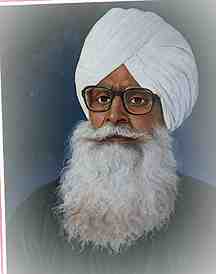
THE ARTIST WHO MADE ALIVE THE HISTORY OF THE PUNJAB - Dr. M.S.Randhawa
A strange-looking artist arranged an exhibition of his paintings in the galleries of All India Fine Arts and Crafts Society, New Delhi, in May 1963. In the age of hippieism it is not at all surprising to see oddly dressed bearded artists with flowing locks, showing their works in the art galleries of New Delhi. I may not have even seen these paintings but for a disparaging review by Charles Fabri in The Statesman. It provoked me to visit this exhibition of unusual paintings by an unusual man. Sitting in the gallery in a basket-chair was a tough-looking Sikn draped in a black chola, wearing a white turban. He was holding a stick with an ivory handle.
On the walls of the gallery were paintings showing ferocious Sikh warriors mounted on prancing horses flaunting spears and flashing swords. These were the paintings, which made your blood tingle and course faster. They radiated fierce energy. Painted i vira-.asa, they evoked heroic sentiment in the beholder. How could Fabri, a Hungarian, feel these paintings, when he had no background of the history of the Punjab and the travail through which the Sikhs passed during the Mughal rule? Moreover, the type of art to, which he was accustomed, was practiced by the artists for its own sake; abstract paintings, which in many cases the painters alone could enjoy. They had no meaning and no message for the average viewer. Here was an artist whose function was to make alive the history of the Punjab in the eighteenth century when the Sikh guerrillas were fighting the tyranny of the Mughal Empire against heavy odds.
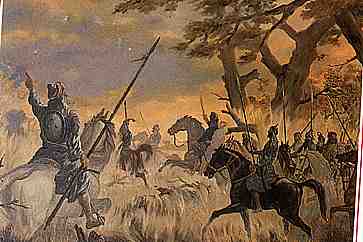
I discovered that this artist was Kirpal Singh and Khushwant Singh had already taken notice of his work in the illustrated Weekly.
Kirpal Singh, a self taught artist with no formal training in an art school. I learnt that he was born on 10th December 1923, in Village Wara Chain Singh Wala in Zira Tehsil of Ferozerpur District. His father S. Bhagat Singh Ramgarhia, was a renowned craftsman. The Jain Temple at Zira has a wooden gate of exquisite beauty carved by him. Incidentally most of the leading artists of the Punjab are carpenters by caste, viz., Sobha Singh, S. G. Thakur Singh and G. S. Bansal. Recent research has revealed that Kangra artists who painted miniature paintings of exquisite beauty in the 18th century were also carpenters. Undoubtedly, there is bond between crafts and art.
Kirpal Singh was educated at District Board High School, Zira. Even as a child he was sensitive to the beauty of colours and spent his spare time watching village girls spinning and embroidering phulkaris in the courtyard of his house. Watching these girls he felt inspired and wanted to do something creative himself. In his own words "I was itching to utilize my fingers by drawing something or making some crude pictures." At that time, drawing was introduced as a subject in Class V. Kirpal Singh spent many hours copying pictures from his textbooks, with a 'G' nib.
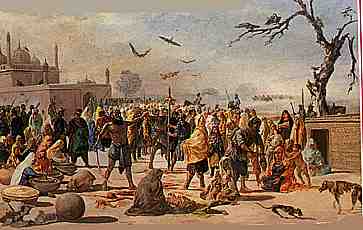
Kirpal Singh passed the Matriculation examination in 1939 and joined the Sanatan Dharam College at Lahore. In 1940 Kirpal Singh paid a visit to historical gurdwaras of Bhai Taru Singh, Bhai Mani Singh, Dehra Sahib and Shaheedganj in Lahore and became aware of the great sacrifices of the Sikhs. At that time, the birth anniversary of Maharaja Ranjit Singh was celebrated at Lahore. Though he was a science student, he spent much time in the study of history. He was greatly moved by the History of the Sikhs, Written by Bhai Khazan Singh. Another book, which made a deep mark on him, was Sundri, a novel by Bhai Vir Singh. After passing F. Sc. in 1941 he joined as a clerk in the Military Accounts Department in Lahore Cantonment, Mianmir. In his spare time he continued to paint landscapes and human figures in water Colours.
In 1945 he married Kuldip Kaur of Village Kadyal in Tehsil Zira. From Kuldip Kaur he has two sons and one daughter. The younger son Jarnail Singh paints and has inherited the talent of his father. On the partition of India in August 1947 Kirpal Singh settled at Jalandhar where his brother was a clerk in the Industries Department of the Punjab Government. At Jalandhar he had an opportunity to see reproductions of the paintings of the Russian artist Repin : Volga boatmen; Religious procession; and Cossacks writing a letter to the Sultan of Turkey, in the Encyclopaedia Britannica. He also became familiar with the reproductions of the paintings of the great masters of the Italian Renaissance: Michelangelo, Leonardo da Vinci, and Rubens. He was deeply influenced by the realistic technique of these great painters.
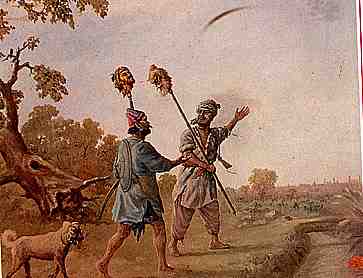
WHOSE FAITH REMAINED UNSHAKEN
The Sikhs were hounded and killed as if in a game
In 1952, Kirpal Singh migrated to Delhi. He earned his livelihood by designing book-covers and drawing book illustrations. Commercial art was not to his taste and in 1953 he came to Karnal and lived in the reclamation farm at Indri. In the quiet atmosphere of Indri he started painting seriously. The subjects of his paintings were women transplanting paddy, caravans of gypsies, and Guru Hargobind in Gwalior Fort.
In June 1955 he arranged the first exhibition of his paintings at Dyal Singh College, Karnal, under the patronage of Principal Sant Rain Grover. Though the paintings were appreciated by the visitors not a single one was sold. The second exhibition of his paintings was held in January 1956 at Lyallpur Khalsa College, Jalandhar, under the patronage of Principal Gurbachan Singh Talib who purchased a few paintings for the college.
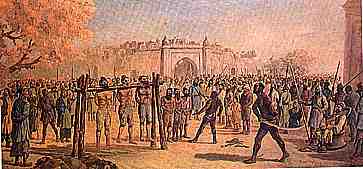
On the recommendation of Professor Satbir Singh, a member of the Shiromani Gurdwara Parbandhak Committee, Kirpal Singh was employed as an artist at Darbar Sahib, Amritsar, at a salary of Rs. 250 p.m. in the summer of 1956. From 1956 to November 1962 he painted 36 paintings of subject relating to Sikh history which are now displayed in the Central Museum of Sikh History, Darbar Sahib, These include his famous painting of the Darbar of Maharaja Ranjit Singh as well as tortures suffered by Sikh men and women during the Mughal rule.
I learnt from Kirpal Singh that he donned black chola on his 35 birthday in 1958 after the fashion of Sufi poets. He regards this dress as a symbol of devotion and dedication to his self-imposed mission and renunciation of worldly matters. He was feeling very unhappy at Amritsar. The Curator of the Museum could not understand his work and there were frequent quarrels. In sheer disgust he left the service of the Shiromani Gurdwara Parbandhak Committee, Delhi. They are now on display in Guru Tegh Bahadur Niwas at Gurdwara Sis Ganj. (Now shifted to Gurdwara Bangla Sahib, New Delhi).
A request came from Guru Gobind Singh Foundation for selecting outstanding events in the life of Guru Gobind Singh. I along with Dr. Ganda Singh selected themes for the paintings and Kirpal Singh was commissioned to paint these subjects. Out of these, seven paintings are now on display in Guru Gobind Singh Bhawan of the Panjabi University, Patiala.
In 1967 when I was Chief Commissioner of the Union Territory of Chandigarh I made a scheme for allotment of building sites on a concessional basis to scientists, writers and artists. In that scheme a plot was allotted to Kirpal Singh and he started construction of a house for residence. At that time I started the scheme of Museum of Evolution of Life for which paintings were required. Kirpal Singh and Jaswant Singh were commissioned to paint large paintings showing the progress of life in the geological past. This was not a subject in which Kirpal Singh was interested, but as he was in need of funds, paintings relating to the Mesozoic period when dinosaurs ruled the earth entrusted to him, and he painted them competently.
At Chandigarh he was also patronised by S. Manmohan Singh, Managing Director of the Punjab Marketing Federation, who is a scholar and connoisseur of art. He was also commissioned by S. Inderjeet Singh of Punjab & Sind Bank to Paint Sikh themes. Army officers also started patronizing him. Twelve of his paintings on the heroic deeds of the Sikhs soldiers during Indo-Pakistan Wars are displayed in the Army Museum at Meerut Cantonment.
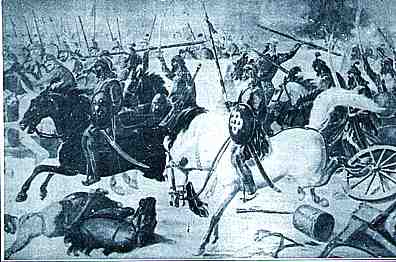
The greatest opportunity for his talents came in 1972 when I started the project of Anglo-Sikh Wars Memorial at Ferozeshah in Ferozepore District. The paintings showing the battles of Mudki, Ferozeshah, Sabraon and Chillianwala were painted by Kirpal Singh. These paintings 10 ft. X 20 ft. in size are the largest ever painted in India. They could not be accommodated inside a residential house, Kirpal Singh erected a tent outside his residence in Chandigarh in which he worked on these paintings for a period of three years. Kirpal Singh also painted the portraits of General Gough, Sardar Sham Singh Attariwala and General Tej Singh. Kirpal Singh is at his best in war paintings where martial ardour is displayed. His paintings of the battles of Ferozeshah, Subraon and Chillianwala are remarkable. In these paintings he has paid tribute to the memory of the valiant Sikh soldiers who fought the British army and almost defeated them in two battles. This Wars Memorial, which in fact is a picture gallery of War paintings, was formally inaugurated in April 1976 at one of the biggest public gatherings in Punjab. Apart from over five lakhs of people who came in trucks and lorries from all over Punjab, Ministers of Punjab Government, Deputy Defence Minister of the Government of India and heads of all the three Services, Army, Navy, and Air and Air Force, saluted Memorial, and thus paid homage to the memory of soldiers who lost their lives in the First- Anglo-Sikh War in 1846 and incidentally to the paintings. Never before had the work of an Indian artist received such recognition.
Kirpal Singh maintains a private library of rare books on Indian history and art. Before he starts painting he makes a careful study of the facts of history, and also studies costumes of the period from paintings of the Mughal, Rajput, Sikh and Company schools.
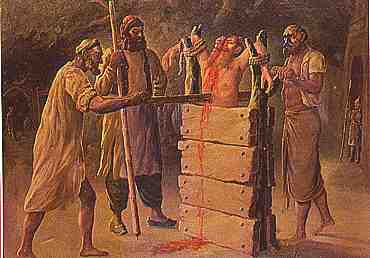
Kirpal Singh is a staunch Sikh and he derives his inspiration from the unparalleled heroism of Guru Gobind Singh. When Guru Gobind Singh, harassed by the Mughal army left Anandpur, he took shelter in the garhi of Chamkaur. Here his two sons Ajit Singh and Jujhar Singh fell fighting the Mughals. In a painting by Kirpal Singh, we see Guru Gobind Singh carrying a bow directing the defence of the garhi. His face radiates power and reckless bravery. We also see defiance and courage in the visage of a Sikh soldier drawing a bow and shooting an arrow.
What a painting can convey, writing cannot convey. Its impact is direct and even an illiterate person can understand the message of the artist. A glance at a painting of Kirpal Singh provides the viewer a better insight into several aspects of Sikh history than he could get by reading history books. Kirpal Singh is truly the artist who made alive the history of the Punjab.

Storming a castle